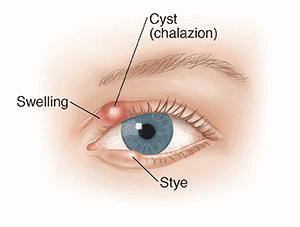 Each eyelid contains on average 25 modified sweat glands that run vertically and drain just behind the eyelashes. These glands constantly produce a tiny amount of thin fatty liquid. This fat normally acts to seal the tear film onto the front of the eye, keeping the tears from evaporating prematurely.
Each eyelid contains on average 25 modified sweat glands that run vertically and drain just behind the eyelashes. These glands constantly produce a tiny amount of thin fatty liquid. This fat normally acts to seal the tear film onto the front of the eye, keeping the tears from evaporating prematurely.
When one of these glands gets blocked, this “liquid” fat solidifies. The gland swells and gets red. After a couple of days it’s walled off into a bump on the eyelid. It is important to get this gland to drain through its natural opening before it gets infected. Otherwise the “fat” in the swollen gland turns rapidly into puss. It breaks through the skin, scars the outflow track and surgery to excise this is needed to resolve.
A chalazion is not the same as a stye, although the terms are often used interchangeably. A stye, medically referred to as a hordeolum, is a bump in the eyelid that occurs when an oil gland becomes infected. It is like a small abscess or “boil” on the edge of the eyelid. A chalazion is an accumulation of material in the eyelid as a result of a blocked oil gland.
Most chalazia and styes resolve by themselves within several days to a week, but sometimes can take months to completely disappear without proper treatment. Warm compresses over the affected area can promote drainage of the blocked gland (see our protocol for warm compresses below). Anti-inflammatory eye drops, ointments or an injection into the bump may be needed if traditional non-invasive treatments are ineffective. Oral antibiotics may also be used if the chalazion or stye is associated with bacterial infection of the surrounding eyelid tissues (cellulitis). A large, swollen, or persistent chalazion or styes might require surgical drainage.
Traditional treatments for chalazia are 50% effective. This protocol is 95% effective, meaning only 1:20 patients will need surgical excision:
- Use a dry heat compress made of rice. These compresses are widely available in a variety of sizes. Or you can make your own! Some of the large ones even have little wooden handles on each end to help wrap them around your neck. These work great if both eyes are affected.
- Put it in the microwave for 1-2 minutes – IF IT IS COOL ENOUGH TO HOLD IN THE PALM OF YOUR HAND, you can apply it to your eyelids. These devices stay warm to hot for 10-12 minutes. This is an adequate time to convert the thick fat into a liquid, just like melted butter.
- The material at the tip of the gland, just behind the lashes, rarely melts – it acts like a cork and you need to uncork it! Gently pressing from the base of the chalazion towards the eyelashes for 30-60 seconds will help loosen the cork. One minute after removing the heat compress, the fat turns back to a solid, so more massage won’t make a difference.
Repeat this procedure four times a day, four days in a row. If the chalazion does not drain, STOP. You have done the best you can do. It is highly unlikely that medical treatment will work for this problem. The lesion needs to be surgically excised (not just drained), injected with a steroid, or both.
*NOTE* – Do not use hot tea bags or boiling water washcloths. They rarely work for a stubborn chalazion. They can also cause second or third degree burns. You may have been told to not massage the lid – without massage after heating, your chances for success are quite low. The sooner you start this protocol, the higher your chances for success!